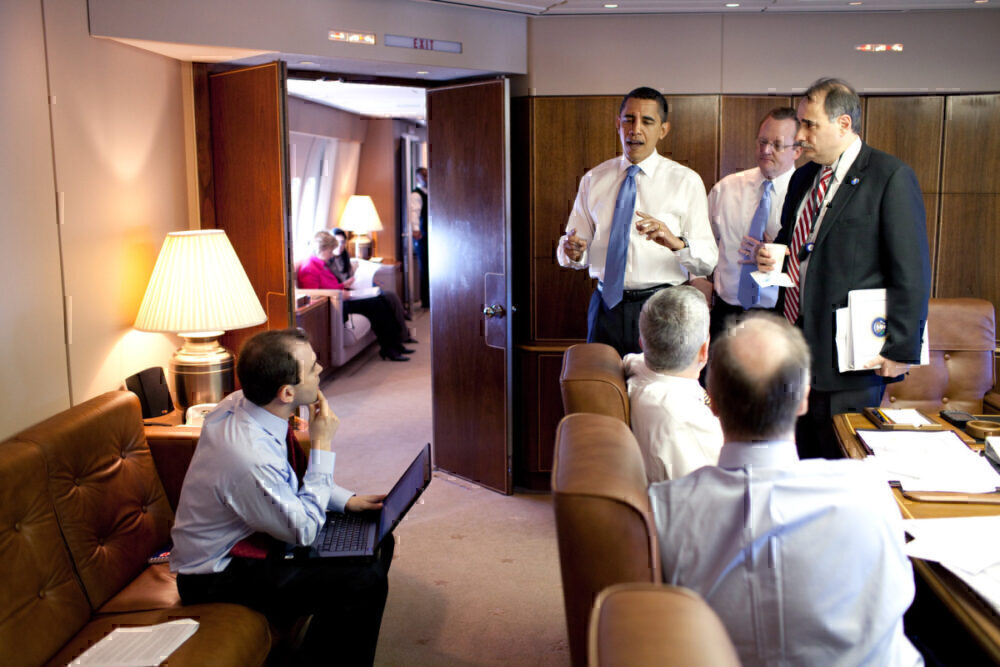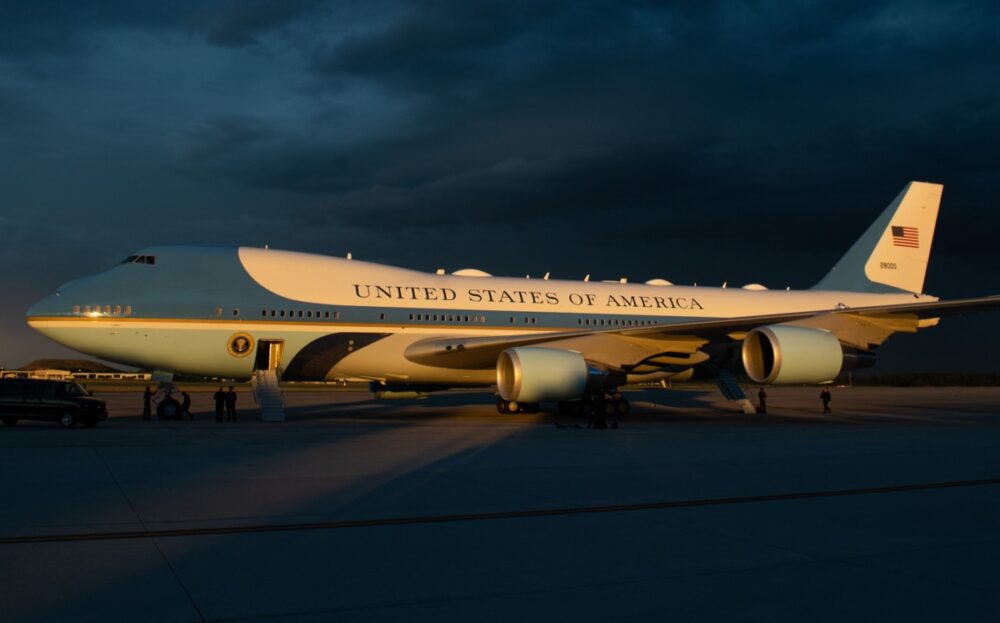The modified Boeing 747s currently used as Air Force One are as large as flying houses. In fact, they are probably larger than most of our houses. Boasting 4,000 square feet of floor space, there’s plenty of room for a stroll around the decks, but what’s actually on board?

A tour of Air Force One
Starting at the front of the plane, up top in the ‘hump’, there is, of course, the cockpit. It’s a pretty standard 747 cockpit, although there are a few more bells and whistles than your average commercial jumbo, but we’ll come to those later. In front of the cockpit, on the nose of the plane, is a midair refueling probe, meaning Air Force One can be topped up with gas to keep it flying for as long as it wants.
Stay informed: Sign up for our daily aviation news digest.

Behind the cockpit is the crew lounge, where pilots and other crew members can rest. This area is mainly used by flight crew, and there is another lounge downstairs for other support crew on the plane. Altogether, there can be up to 26 crew members working on any one flight.
To finish off the top deck, behind the crew lounge, is a state-of-the-art communications center. The room houses some 240 miles of wiring to support the 85 telephones and 20 TVs onboard the plane. As well as this, the comms room has all the latest radar, tracking and defense systems, and it’s fully shielded from electromagnetic interference from nuclear explosion.
The Oval Office in the sky
Down below, in the very nose of the plane, is the president’s private quarters. This suite includes a bed, sofa, dressing room and a bathroom with a shower. There is also a small gym, so that he or she can stay sharp.

Behind the suite is the president’s office. It really is the Oval Office in the sky, with a large desk and room for the president to chat with their advisors and special guests in private.

Sometimes the president will address more than just their personal guests from this room too. Following the September 11th attacks, the office was upgraded with the necessary telecommunications equipment to broadcast an address to the nation from 30,000 feet.

Behind the office is a full medical suite. Here, you’ll find a defibrillator, blood supplies and all the equipment necessary to perform emergency first aid onboard. It can even function as an operating room! Whenever the president flies, there is always a qualified MD onboard, just in case.

Catering for 100
Next along the corridor is the galley. Much larger than those on a regular commercial jet, this galley accommodates three members of staff – a chef, a sous chef and a bartender. Between the three of them, they can whip up gourmet meals for around 100 people and can store enough food to prepare a total of 2,000 meals.
And it’s a good job too, because Air Force One has a vast capacity for additional guests aside from the president and their aides. 102 passengers, in total, can be accommodated onboard, including crew, and will be assigned seating based on their hierarchy in the presidential entourage.
Immediately along the corridor, past the galley, is a small room for senior staffers. Relatively compact, this room has comfortable business class style seats arranged in a circle and is where the president will have their private chats with important members of their team.

Next up is the sizeable conference room. Eight executive leather chairs are arranged around a large central table, with additional sofa seating against the walls for aides and other guests. The room is dominated by a large TV screen, which can be used to keep up with the news or to hold videoconferences with people on the ground.

The conference room often doubles up as a dining room for the president and their guests.


Further down the back
Right behind the conference room is a space for the president’s office staff. This room is equipped with WiFi, fax machines, phones and TVs, letting the president do all their business wherever they are.

Continuing further down the plane, the rooms get more compact and start to resemble something more like we would expect on a commercial aircraft. Behind the office staff room is a guest section of the plane. This looks much more like a commercial aircraft cabin, albeit a premium business class cabin at that.


Next up is a security area for the president’s detail to rest, as well as bathrooms for the guests and press onboard.

Speaking of the press, it might surprise you to know that they don’t board the plane up those iconic front steps that we have watched many a president waving from. No, they must board the plane from the back, using a separate set of stairs often unnoticed by the public. From there, they are housed in a pretty average looking cabin, only getting sight of the president should he or she deem to make an appearance.

What about security?
As you might imagine, Air Force One is something of a flying fortress, equipped with various defense systems to keep the president safe. Indeed, the plane has often been called the ‘most secure aircraft in the world.’
Much of the defense technology onboard Air Force One is classified, for obvious reasons. However, we do know that the pane is outfitted with electronic countermeasures (ECM) to jam enemy radar. It also has IRCM (Infrared Counter Measure) systems to divert heat-seeking missiles by disturbing their guidance systems.

Chaff and flares can be launched from the wings of Air Force One. These divert radar-guided missiles and mislead heat-seeking missiles, respectively. Under the belly of the plane is a device that is based on Northrop Grumman’s AN/AAQ-24 and dubbed Department of the Navy Large Aircraft Infrared Countermeasure (DON LAIRCM) system. The LAIRCM is capable of deflecting Surface To Air Missiles (SAMS) and man-portable air defense missiles (MANPADS).
Finally, the entire aircraft is coated in armor plating, designed to withstand nuclear blasts on the ground, while all the windows are equipped with armored glass.
Were you surprised by any of the features of Air Force One? Let us know what you think in the comments.
[ad_2]
Source link


